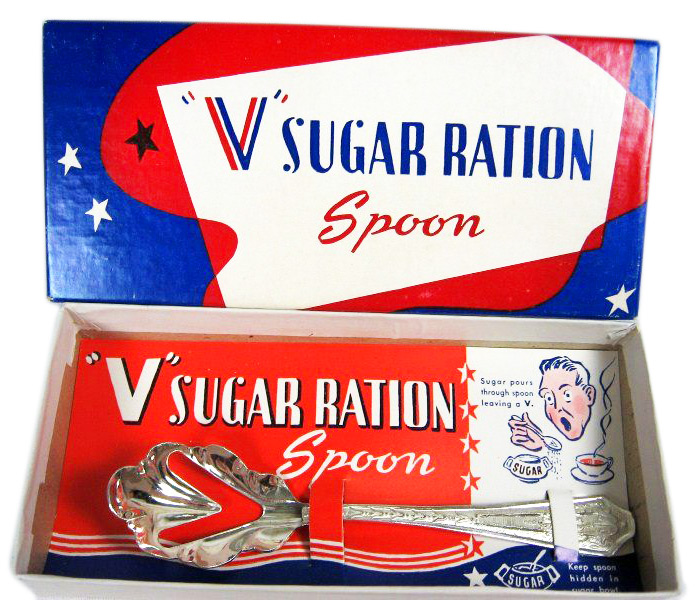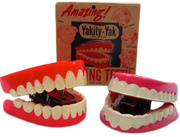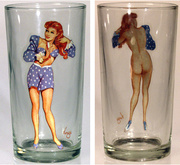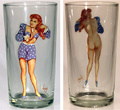It’s all about the toilets—thousands and thousands of tiny toilets. Ever since I first encountered Mardi and Stan Timm, the foremost collectors of novelties produced by H. Fishlove and Co., they’d tell me about gag boxes. But I just didn’t get it. I was more interested in other Fishlove innovations—chattering teeth, beer glasses with naked pinups inside, and, of course, fake rubber vomit. I couldn’t quite get my brain around why the Timms were so crazy about these old-fashioned gags, until they summed it up for me in two words: Bathroom humor.
Turns out, the company’s head honcho, Irving Fishlove, was obsessed with farts and poop. Or as the Timms delicately put it, “The Process of Elimination.” That’s actually a chapter title in their upcoming self-published book on Mr. Fishlove and his company called, “The King of Gag Boxes.” The Chicago couple recently took the time to explain, in their usual hilarious and charming manner, why they’ve collected more than 200 gag boxes.
Collectors Weekly: What is a gag box exactly?
Mardi Timm: The whole idea of the gag box is to entice you to open it up, just like the greeting card. With a funny greeting card, you read the outside, and it entices you to open it. And then when you open it, of course, it’s a gag. It’s not what you were expecting at all. And that’s exactly what gag boxes are all about. It’s a bait-and-switch.
Stan Timm: In the book “Cheap Laffs” by Mark Newgarden, the co-creator of Garbage Pail Kids, he says gag boxes are “essentially three-dimensional greeting cards, often aggressive in tone and risqué in content.” It’s like a joke card, except it’s a box that has a three-dimensional object in it, like a tiny, little toilet—where I guess the greeting card might have a picture of a toilet.
Collectors Weekly: What’s with the toilets?
Mardi: Toilets were Irving Fishlove’s thing. Well, anything to do with elimination, really. Fishlove focused on toilets when, in 1924, TootsieToy started making doll-house furniture using a new injection-molding process. One of the items they made was a toilet.
“We’ve had combat fatigue cases that never cracked a smile for weeks until somebody handed them a gag.”
When Fishlove looked at that toilet, he didn’t see doll-house furniture. He saw funny. And so he started making all kinds of gags using this little toilet. The beauty of it was that Fishlove could use the same toilet in any gag box. His strategy was pretty ingenious, actually. He would just order tons of these toilets for gag boxes. All he had to do was change the wording on the box. For example, we have one that looks like a stop sign in a stand, and it says, “Parking Limit 30 Minutes.” And when you open it up, there’s a toilet inside.
Sometimes he would use a little chamber pot instead, and sometimes he would use them in combination, showing the passage of time. For example, for the 1933 Chicago World’s Fair, one of his most famous gag boxes was called “A Century of Progress,” which, of course, was the theme for the fair [see image at top]. Inside, on one side is a chamber pot, and on the other side is a toilet.
Collectors Weekly: What else would Fishlove put in his gag boxes?
Mardi: A lot of these are in pretty poor taste, actually. An example in the book “Cheap Laffs” says, “Don’t Be an Alcoholic” on the outside of the box. When you open up the box, it says, “Drink Milk,” and it has two boobs.
Stan: Their sense of humor was such as the times. The whole idea of the gag box evolved over time, and the type of containers changed, too. The parking limit gag box is an early one, small enough that it could be a pocket gag. We suspect that at time people would carry one of these around in their pockets and then show it to somebody and, they’d go, “ha ha,” etc.
Mardi: There’s an early one, it has to be from the 1920s, and it’s called “Cob Petit.” This one is aimed at women, which is very unusual because most gag boxes were aimed at men.
When Fishlove looked at that toilet, he didn’t see doll-house furniture. He saw funny.
It’s very elegant looking, and it says “Cob Petit for M’Lady: a creation by Corné.” And then you open it up and it has a little paper cover, with a nice poem, “To an Old-Fashioned Girl.” It says, “Here’s to m’lady fair, who dares to hold the customs of old and the devil that may care.” And it goes on, “For there was no stool or toilet tissue in Grandma’s day. No fancy latrines or blues or greens dolled up in a modern way. No tubs or sinks, orchid or pink, no gadgets that had to match, just the good, old cobs to do the job with neatness and dispatch.” And when you lift this little paper cover, it has tiny corn cobs inside.
Collectors Weekly: It’s referring to the time when people wiped themselves with corn cobs hung inside outhouses?

When “Gone With the Wind” made it big, the name was adopted for “elimination” jokes. This gag box is made from a book.
Stan: Yeah, a lot of young people wouldn’t even know what you’re talking about.
Mardi: Well, nowadays they wouldn’t.
Stan: They wouldn’t know, but at that particular time, I’m sure that gag box was extremely popular.
Mardi: Corn cobs or catalogs [black-and-white Sears Roebuck catalogs also served as early toilet paper] were used in Fishlove gag boxes all the time. Again, he was fascinated by elimination. He also used a lot of beans, too, to represent flatulence. When the “Gone With the Wind” movie came out in 1939, that was one of the big themes. The gag box said “Gone With the Wind” on the cover, and when you pushed out the little slider box—it was like a little matchbox—it had beans in it.
Stan: You see, the whole idea, of course, is that if you eat beans, you know, you have …
Mardi: Flatulence.
Stan: … you let little pooties.
Mardi: They used real beans; beans are cheap.
Collectors Weekly: What was the first gag box?

Early Fishlove gag boxes, first produced in the 1920s, were the size of small matchboxes and conceptually simple.
Stan: Fishlove was huge in the history of the gag boxes. However, he did not start the gag box. In the late 1800s, you could buy them. They were made out of wood. I have one that has a cork on it, it’s like a wooden pillbox, and it says “shoot here to relieve that distressed feeling.” It was probably from around 1915, or maybe a little earlier. And you open it up and there’s a little commode.
What’s interesting about gag boxes is that the copy on the outside almost never told you what was inside. It was up for you to buy it and then find out actually what the joke was.
Collectors Weekly: So the joke was on you, too?
Mardi: The joke was always on you. In the early years, gag boxes would focus on racial themes. Those didn’t seem to last very long. For example, one gag box says “One Pair Undressed Black Kids,” with a picture of kid-leather gloves. And this is not nice, but you would open it up, and there would be two little figures of African American babies. The two oldest ones we have are like little wooden pill bottles, with a cork or some kind of stopper in the top. One of these older ones from the early 1900s says “Matrimonial Prospects, Handle With Care” on the outside. And when you pull the cork out, there’s a string attached to it and on it are little metal women, who are naked. It’s a strange, sexist thing.
Stan: You have to remember the times. They might have been really funny, and now it’s like “What are you talking about? I have no idea what they mean.”
Mardi: Yes, what in the world would that mean?
Collectors Weekly: How did gag boxes change throughout their history?

This tiny gag box contained the same charms used in Cracker Jack boxes and Monopoly board games. They could be worn on charm bracelets.
Mardi: In the early 1920s, the first gag boxes that Fishlove came out with were tiny. They were little sliders, like matchboxes, but they were very small. Inside the gag box, he would put a charm.
The charms were actually, most often, the same toys that appeared in Cracker Jack boxes. They could be worn on charm bracelets, too. It was the Dowst company that created TootsieToy, and they made those little charms. They also made the pieces for Monopoly players when the Parker Brothers board game came out. The prizes in Cracker Jacks, the pieces in Monopoly, and the objects in Fishlove gag boxes were the same toy. The companies were all in Chicago, so they collaborated. One of the earliest Fishlove gag boxes was a “Ford Tool Chest.” It was a tiny slider box that was maybe 1 by 2 inches. Inside were tiny tools, like a wrench and screwdriver.
Stan: Now, that isn’t even funny, but you have to think about the times; when they first came out, Ford was the No. 1 company that made cars.
Mardi: Early on, some gag boxes had riddles on the outside instead of a funny saying. And those were small, too. Then, they slowly started getting larger.
Stan: In the ’30s, gag boxes started to become mailers, so the boxes had to became larger, so you could write “to whom” and “from whom” on it. Then, they made gag boxes out of old books. They would take a book, cut a hole in the pages, and paste something different on the cover. For example, I’ve got a book gag box here—this one was made by S.S. Adams. The cover says, “A collection of shapely pinups in full color but stripped of all their clothes.” And it’s in an actual book, which is called, “America.”
But when you opened it up, the pages have been cut out in the center, and it holds a bunch of clothespins there of different colors. So it’s pinups—clothes pinups—right? They’re shapely and full color—they’re all different colors. They’re stripped of all their clothes because there’s no clothes hanging from them.
Mardi: When you started getting into mailers, not only did gag boxes get larger, but they also came in different shapes. At that time, you could mail just about anything because they didn’t have machines to sort the mail. Of course, in the ’40s, gag boxes were mailed to servicemen, but they were also mailed as souvenirs. Especially as people started traveling more in the ’30s.
Collectors Weekly: What kind of gag boxes would you find in cities like San Francisco or Chicago?
Mardi: Well, the gag didn’t relate necessarily to where it was sold. It just was your typical souvenir funny thing that happened to be labeled for a particular city.
Stan: Yes, usually the city name was printed or stamped on in gold lettering. But I think what happened is the store, wherever it was, say, in Columbus, Ohio, would contact Fishlove and say they wanted X number of things, and they would get the city name printed on each of them. So somebody could be traveling through Columbus, pick up this gag, and then send it to their friend.
Mardi: I remember when I was young in the 1950s, there was a very popular restaurant chain called Stuckey’s. When you stopped in there, it had a whole big section of souvenirs, and you could spend hours looking at all them. A lot of those souvenirs were gag boxes.
Collectors Weekly: How did gag boxes change during World War II?
Stan: Gag boxes, usually mailers, were very popular during World War II for the troops. On the backside, it had places marked “To” and “From” and a spot for your stamp. People would do tie it up with an old piece of string and put it in the mail. According to a 1960s True Magazine article we have, during the war, Irving Fishlove was told, “Wherever Bob Hope goes, your gags will go.”
Mardi: Apparently, Fishlove was trying to find out why his gag boxes held a priority with the mail service during World War II. Why did his stuff go to the troops, when other stuff didn’t? So in Washington, he asked the U.S. Postal Service, and they said, “We’ve had combat fatigue cases that never cracked a smile for weeks until somebody handed them a gag.” Ain’t that neat? So Fishlove gags were incredibly important for the war effort.
Collectors Weekly: Were there specific kinds of gag boxes for the soldiers?
Stan: Yes. There were about three or four gags they emphasized for the troops, and they did them with the toilets again.
Mardi: At the time, there was a draft. And so one showed a soldier on the outside saying, “If You Gotta Go, You Gotta Go …,” the idea being that you’re being drafted. And you open it up and there would be a miniature toilet in it.
Stan: People also sent soldiers a lot of girlie-type boxes which contained an unclad young lady or tiny cloth panties inside.
Mardi: Yeah, a lot of girlie things. But as time went on, as you got past World War II and started moving into the ’50s, like Stan said, the boxes got bigger and they featured very different things, like boobs. Boobs were big.
Collectors Weekly: So gags boxes had a lot of latex boobs in the ’50s?
Mardi: Yes, but during the ’50s, gag boxes also became less and less risqué, and the toilet jokes faded away. The ’50s were such a conservative time. But Fishlove made things that reflected the era, like jokes about the diet industry. Now, you were getting more gag boxes for women, which wasn’t normal in the earlier years. One was a tool kit for dieters. It says, “Dieter’s Delight: The easy, happy way to stop gaining weight.” And when you open it up, there’s a spoon with a hole in it, and a fork and a knife that are cut off.
Stan: As we got into the late ’50s and then the ’60s, the demand for gag boxes really started to go down. Why exactly that happened, we’re not totally sure. Times changed. Today, it’s not much of an industry. The company that bought Fishlove, Fun Inc., I think they still do a comb for a bald men.
Mardi: Yes, it’s a brush for bald men, which is a handle with a washcloth on it. And then there was a comb for bald men, which was a comb with no teeth in it.
Stan: But it’s even tough to find those. And you’ll find just a little smattering of gag boxes but not much of any. It’s a lost whatever.
Mardi: Yes, it’s kind of gone.
Collectors Weekly: So if one wanted to start gag box collection, what do you need to know?
Stan: There’s such a wide variety of them. Fishlove is probably the major manufacturer, but there were other companies that made them, like S.S. Adams and Franco American. And they are still relatively unexpensive to buy.
Mardi: They’re pretty much Fishlove’s niche. Fishlove was the king of gag boxes.
Stan: He really made these quite popular. And he came out with hundreds of different gag boxes, just by changing the label. As a collector, you can have several where you open it up and there’s this toilet inside, and the label on the cover might be different for every one of them. It’s still the same toilet.
Mardi: That way, he could sell the same joke over and over and over and over again. It was hugely profitable because he never had to buy new stuff.

The “Hair Brush for Bald Heads” is one of the few gag boxes still made by Fun Inc., the company that bought H. Fishlove and Co.
Stan: And he was fascinated with toilet jokes. It’s amazing how many gags he came up with just using that.
Mardi: When we interviewed Irving’s son Howard Fishlove once, he said, “I think my dad had toilets on the brain.” Everything he did for years was related to toilets or flatulence. One of their biggest sellers was the first receiving set.
Stan: Oh yeah yeah yeah! That came out in the ’20s, when radios were the big rage. So it said “The Original Receiving Set,” and the picture was this tower with the rays coming out. And you’d open it up and, of course, it was a toilet. Sometimes the toilet would be printed with a company’s name, like a hardware store.
Mardi: Gag boxes would be given away by companies as advertising premiums. Fishlove made those as well, printing the company name on the same gag box, instead of a city.
Stan: He would do anything to make a buck.
Mardi: Yes. And most of time, it related to toilets.
(All photos, except the final image, are courtesy Mardi and Stan Timm.)












 Girlie Glasses: A Peep Show With Your Beer
Girlie Glasses: A Peep Show With Your Beer
 Yakity-Yak: 60 Years of Teeth That Talk Back
Yakity-Yak: 60 Years of Teeth That Talk Back Girlie Glasses: A Peep Show With Your Beer
Girlie Glasses: A Peep Show With Your Beer Playing With Matches: Sexy, Silly 1930s Ads That Went Up in Smoke
Playing With Matches: Sexy, Silly 1930s Ads That Went Up in Smoke Mari Tepper: Laying it on the Line
Mari Tepper: Laying it on the Line Nice Ice: Valerie Hammond on the Genteel Charm of Vintage Canadian Costume Jewelry
Nice Ice: Valerie Hammond on the Genteel Charm of Vintage Canadian Costume Jewelry How Jim Heimann Got Crazy for California Architecture
How Jim Heimann Got Crazy for California Architecture Modernist Man: Jock Peters May Be the Most Influential Architect You've Never Heard Of
Modernist Man: Jock Peters May Be the Most Influential Architect You've Never Heard Of Meet Cute: Were Kokeshi Dolls the Models for Hello Kitty, Pokemon, and Be@rbrick?
Meet Cute: Were Kokeshi Dolls the Models for Hello Kitty, Pokemon, and Be@rbrick? When the King of Comedy Posters Set His Surreal Sights on the World of Rock 'n' Roll
When the King of Comedy Posters Set His Surreal Sights on the World of Rock 'n' Roll How One Artist Makes New Art From Old Coloring Books and Found Photos
How One Artist Makes New Art From Old Coloring Books and Found Photos Say Cheese! How Bad Photography Has Changed Our Definition of Good Pictures
Say Cheese! How Bad Photography Has Changed Our Definition of Good Pictures Middle Earthenware: One Family's Quest to Reclaim Its Place in British Pottery History
Middle Earthenware: One Family's Quest to Reclaim Its Place in British Pottery History Fancy Fowl: How an Evil Sea Captain and a Beloved Queen Made the World Crave KFC
Fancy Fowl: How an Evil Sea Captain and a Beloved Queen Made the World Crave KFC
I remember gag boxes from the dime store of my childhood. There were a lot of them, and you could see what was inside before you made your purchase. The one that sticks out in my memory was labeled “plain and fancy birth control” and had two corks inside. The fancy one had a flower painted on it. I guess I remember that one because it was pretty risque to my 10-year-old sensibilities.
I remember one (early 60s maybe?) … How to screw in the dark.
When you opened it, it held a small screwdriver and a little penlight.
Seems like I remember these things at Stuckey’s on the family vacation road trips.
I was a friend and producer for Irving Fishlove back in the late 40’s and early 50’s. I’m now 91 and live in Tiburon, Ca. Back then I lived in Chicago and was a
designer and producer of injection molded plastic products. Irving gave me the job of redesigning the Yackity-yak teeth for molding in polystyrene which I did and then produced many thousands of them. I remember his passing probably 40 years or so ago and his son Howard who was interested in the theater.
I’ll look forward to your book when it comes out…meanwhile I was delighted to view for posting. What an amazing world, eh?
Bill Caddell
I wanted to add to this list of items created by Fishlove and Company history story. My Dad bought my Mother the beating heart made by this company for a Valentine’s Day gift. They were married on Valentine’s Day in the mid 40’s, so Valentine’s Day was really important to them. I am so glad to see that their was a practical joker company out there already – practical joker, that was my Dad.
I recently picked up one of the older items mentioned in the story, the wooden pill bottle matrimonisl prospects. 4 metal girls on a string. Any idea of value?
Are you aware of the Tootsietoy U.S. MAIL van issued in a gag gift box labelled “FOR MAIL ONLY ” and issued in 1928 by H. Fisheluv & Co.? It is very highly regarded and valued accordingly.
I have an old whiskey brown flask pint bottle that says produced by lovejoy and it says Old salty whiskey? Looks real?? 1934…has sailor face on it?? ANY IDEA?